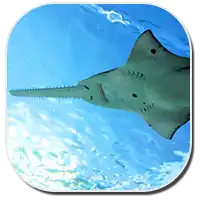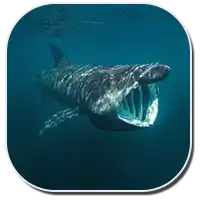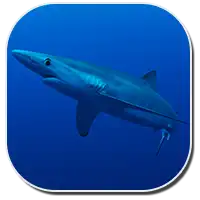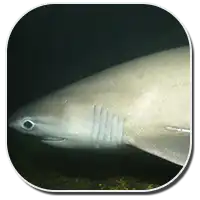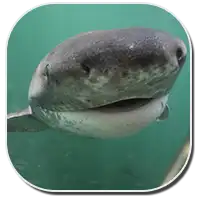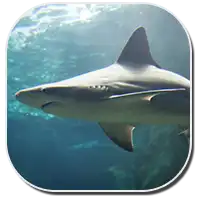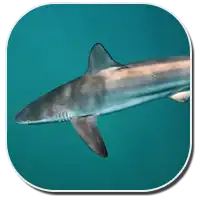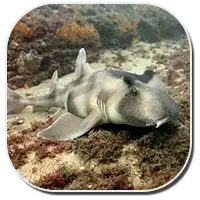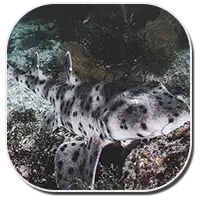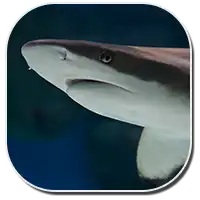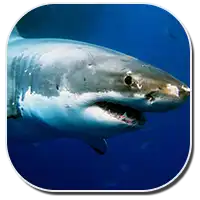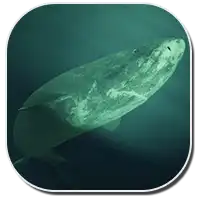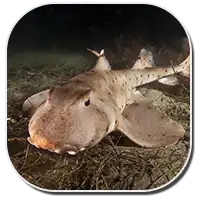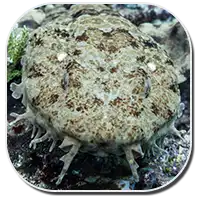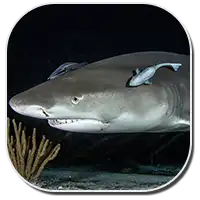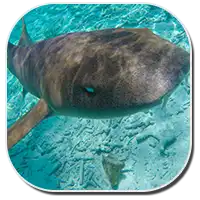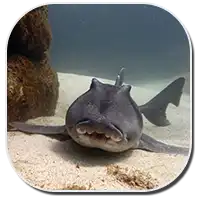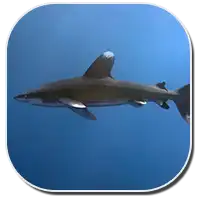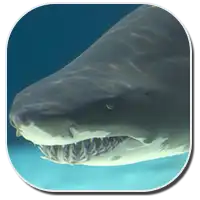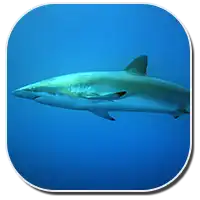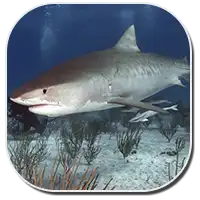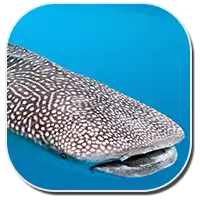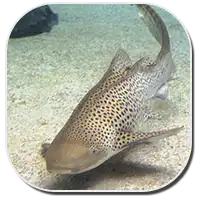More than 450 types of sharks exist in the world today and thousands of shark species have come and gone over the course of millions of years! It’s going to take a while, but this site will continuously be updated as we are able to add more shark species to the list below.If you’re looking for a specific kind of shark, feel free to use the search feature below. Otherwise, check out the shark breeds listed below in alphabetical order. I hope you find this info to be interesting and helpful!
Search For A Type Of Shark
The Bahamas Sawshark (Pristiophorus schroederi) belongs to the family Pristiophoridae. In contrast to its Asian “congener” (that’s scientist-speak for member of the same genus) that we recently featured – the Pacific-dwelling Japanese Sawshark (P. japonicus) – this species lives in the Atlantic Ocean. It is also known as the American Sawshark.
The Basking Shark, which is also known as the Cetorhinus Maximus, is the second largest fish in existence (the first largest is the whale shark). Interestingly enough, although the size of the basking shark is incredibly large, its diet only consists of plankton. These sharks can live in cold as well as warm temperature waters. The mouth of a basking shark is very recognizable. Their mouths are tremendously large; they can be well over 3 ft (1 m) in width!
Bigeye Sixgill Shark
The Bigeye Sixgill Shark (Hexanchus nakamurai) is one of two living sixgill shark species. These large fish belong to the cow shark family (Hexanchidae), within the larger Order Hexanchiformes. They are wide-ranging and important apex predators, meaning that they are right at the top of the food chain in coastal and deep-water ecosystems.
The small, but lightning fast Carcharhinus Melanopterus, or Blacktip Reef, is the smallest of all Reef species. At most, it is 1.5 to 1.9 meters (5 to 6 feet) long and only weighs 20 to 25 kilograms (44 to 55 pounds). This species loves the warm and shallow water near sandy beaches and coral reefs. It gets its name from the pointed snout and black tips on its fins (especially its dorsal fin). This is considered one of the most beautiful sharks in the Ocean and are seen often by divers since this species prefers shallow waters.
Related Articles
Reef Shark, Carribbean Reef Shark, Gray Reef Shark, Silvertip Reef Shark, Whitetip Reef Shark
The Blue Shark is one of the most beautiful of all sharks. Unfortunately, it’s also one of the most over fished sharks in the world. Also known as the Prionace Glauca, they are easy to identify because of their special slim, torpedo shaped figures. Their swimming is very elegant and they are known to be exquisite swimmers. They reach up to 4 meters in length (13 feet) and weight up to 205 kilograms (450 pounds).
Australia’s northeastern coast is home to this small and uncommon bottom-dweller, known as Brachaelurus Colcloughi. It is a prime example of the ordinary, poorly known species that are easily forgotten when it comes to shark conservation. Yet these cryptic critters are just as important to marine ecosystems as the big, flashy sharks that grab all the attention.
The Bluntnose Sixgill Sharks are primitive sharks (genus Hexanchus) belonging to the Hexanchidae family (“cow sharks”). These deep-water predators are distinguished by the following features: they have six pairs of long gill slits on each side of their broad head, comb-like, yellow lower teeth, and a long tail. The Bluntnose (H. griseus) is the larger of the two sixgill species, and indeed is one of the world’s largest sharks. It ranges widely in boreal, temperate and tropical seas. Its appearance is similar to fossil shark forms that date back roughly 200 million years, to the Triassic period.
The Broadnose Sevengill Shark (Notorynchus Cepedianus) is the only common, coastal member of the cow shark family, Hexanchidae – most other members prefer deep-water. Thus, while the basic biology of the whole group remains somewhat mysterious, this large species has been studied more than most Hexanchoids (along with the Bluntnose Sixgill Shark). It is distributed widely in the world’s temperate coastal waters.
The Bronze Whaler Shark (Carcharhinus Brachyurus) has nicknames such as “Narrowtooth Shark,” “Bronzys,” “Copper Shark,” and “Bronze.” These Bronze Whaler Sharks inhabit subtropical waters, and they feed on smaller sharks, rays, and bony fish. Unfortunately, Bronze Sharks are prime targets for both commercial and sports fishermen.
The Bull Shark – They’re everywhere you wouldn’t expect them to be! Known as the Carcharhinus Leucas in the scientific community, it has a stocky figure and a broad, flat snout. This is one of 43 shark species that can live in both seawater and freshwater. That fact alone makes this one of the best known shark species. This species is known by several different names depending on its whereabouts: Zambezi Shark, Nicaragua Shark, or Ganges River Shark. But this shark is also known as one of the top 3 sharks most likely to attack humans (the other 2 are the Great White Shark and the Tiger Shark).
The Burmese Bamboo Shark, also called Chiloscyllium Burmensis, is a rare fish that lives in the tropical waters off Burma (Myanmar) in Southeast Asia. It belongs to Family Hemiscylliidae, the group known as Longtailed Carpetsharks or Bamboo Sharks. This species is a small shark: the “type” specimen (the individual that was used to describe this species) measured just 57.5 cm (22.6″) long. It is housed at the Smithsonian Institution, in the National Museum of Natural History in Washington, D.C. This genus of sharks has a long, distinctive snout. The pectoral and pelvic fins are thin and not very muscular. The species has no distinct color pattern.
The Carcharhinus Perezi, better known as Caribbean Reef Shark is at most 3 meters in length and 50 to 70 kilogrammes in weight. This shark species is very similar to the Gray Reef Shark which is only found in the Indo-Pacific. They also can be easily confused with a number of other shark species like the Blacktip Shark, the Sandbar Shark, Dusky and Silky Sharks and the Galapagos Shark.
Related Articles
Blacktip Shark, Blacktip Reef Shark, Gray Reef Shark, Reef Shark, Silvertip Shark, Whitetip Reef Shark
The Caribbean Roughshark (Oxynotus Caribbaeus) is a small, rare, shark that stays close to the ocean bottom in the Gulf of Mexico and the Caribbean Sea. Little is known about the life history of this enigmatic species, which was described in 1961 yet was only lately observed in its natural environment. There’s no chance that you’ll mistake this species for the very similar-sounding Caribbean Reef Shark (a large requiem shark).
The Cookiecutter Shark (Lsistius Brasiliensis) is a member of the “sleeper shark” family, Dalatiidae. This group in turn belongs to Order Squaliformes, the Dogfish Sharks. Physically it looks like a typical dogfish, with a long thin body, a short cone-shaped snout, and no anal fin. The skin is greyish brown, with a darker brown area around the throat and gills, and a lighter belly. The Cookiecutter Shark is named after the cookie-shaped wounds that it leaves on the bodies of its prey. This small fish is also known as the cigar shark because of its body shape. It lives in the deep-waters of warmer areas worldwide. Adult males can grow up to 42 cm (16.5″) long, and females grow a little larger, up to 56 cm (22″) in total length.
The Copper Shark (Carcharhinus Brachyurus) is a coastal species that can grow up to 3.5 m (11.6 ft) long. It is a “requiem shark” (family Carcharhinidae), which are large sharks like the Tiger Shark that are usually found in warm seas. This one is also known by many other common names including Narrowtooth Shark, Bronze Shark, Cocktail Shark, Bronze Whaler, and New Zealand Whaler. It is easily confused with other large requiem sharks, including members of the same genus such as the Blacktip Shark, (C. Limbatus) and the Spinner Shark (C. Brevipinna).
The Crested Bullhead Shark (Heterodontus Galeatus) is a small, not-too-common, bottom-dwelling species that lives off the eastern coast of Australia. Other names for this funny-looking creature include “Crested Horn Shark” and “Crested Port Jackson Shark”. It’s base skin color is a light, tawny brown, with broad bands across the head, back and tail. This is a member of the Bullhead and Horn Shark family (Heterodontidae), along with some of its close relatives that we have featured here: the Horn Shark, and the Galapagos Bullhead.
The Frilled Shark, also known as the Frill Shark, has not changed much since prehistoric times. This shark closely resembles an eel, however because of its six gill slits, it is actually cousins with the Great White Shark and the hammerhead shark. The frilled shark has nicknames such as “Loch Ness Monster,” “Sea Serpent,” and “Living Fossil.” This shark can be found in the waters of Australia, the Caribbean, Chile, West Africa, New Zealand, and Southeast Asia.
Despite its unmistakable appearance, little is known about the life and ecology of the Galapagos Bullhead Shark (Heterodontus Quoyi). This tropical / warm-temperate species is alternately called the Peruvian Horn Shark. It belongs to the Heterodontidae (Bullhead and Horn Sharks), a family of small sharks that dates back to the Jurassic period. It can grow up to 1.07 m (3.6 ft) long. A large head, snub snout, and dark spotting on its greyish-brown skin give this fish the look of bizarre, skinny cross between a leopard and a pig. Relatively large pectoral fins add to its distinct look and enable this shark to crawl along the ocean floor.
The Goblin Shark can be found in the waters of the western Indian Ocean, the western and eastern Atlantic Ocean, and the western Pacific Ocean. These sharks dwell at the bottom of the ocean, as low as 3,940 feet (1,200 m). For this reason, Goblin Sharks are rarely seen, and unfortunately, very little is known about these mysterious sharks.
The Gray Reef Shark, also known as the Bronze Whaler Shark, Short Nose Blacktail, or Carcharhinus Amblyrhynchos, is a beautiful medium sized shark which can be distinguished from other sharks by the plain white-tipped dorsal fin and the dark tips on all other fins. The Gray Reef typically grows no larger than 2.5 meters (8 feet) and 35 kilograms (77 pounds) in weight. This species can live to about 25 years of age. What really sets this shark apart is its keen sense of smell.
Related Articles
Blacktip Shark, Blacktip Reef Shark, Carribbean Reef Shark, Reef Shark, Silky Shark, Silvertip Shark, Whitetip Reef Shark
The Great Hammerhead Shark is by far one of the most famous sharks around. Everyone knows this amazing creature exists, but here we’ll dive into some of the more interesting facts about one of the most amazing species of fish in the world. The most well known factor about them would undoubtedly have to deal with their namesake. These sharks have flat, T-shaped heads that make them stand out from other sharks. Many people are highly intrigued and curious about the shape and benefits of the Hammerhead Shark’s head.
Related Article
The Great White Shark is arguably the most famous, and possibly the most feared. These marvelous creatures grow about 10 inches (25 cm) annually until they are fully grown. At the adult stage of their lives, their lengths can range from12 to 14 feet (3 to 4 m). Although many picture great whites constantly feeding on helpless victims, they can actually go 3 months without eating!
Related Article
The Greenland Shark is extremely large in size, and prefer to live in exceedingly cold temperatures. Although these sharks are massive, they actually grow relatively slowly. In fact, some Greenland Sharks have been recorded to only grow 1cm per year. Not only do these sharks grow at slow paces, but they also move slowly; this is a very interesting fact because they favor fast-moving fish during feeding time.
The lifespan for most Hammerheads is between 25 and 35 years. It’s likely that over time, they are beginning to live longer lives. The reason for this is currently unknown. The eyes of this shark are placed on the outer edges of the hammer. This allows them a vertical 360 degree view, which means the Hammer head shark is able to see both above and below quite easily. Unfortunately, this eye placement causes a huge blind spot directly in front of their nose! This fish is well known for its ability to make very sudden and sharp turns. Not only does the hammer at as an organ of balance, but its body seems to be specifically designed to twist and bend.
The Horn Shark is a small, common, bottom-dweller in the warm waters off western North America. It belongs to the Bullhead Shark family (Heterodontidae). Its name comes from its short, blunt head with high ridges above the eyes. It has large spines on its two high dorsal fins, and many small dark spots on brownish gray skin. Most adults measure about 1 m, and the maximum length of this species is 1.2 m (3.3 ft). Horn Sharks have a small home range, usually no larger than 1,000 m². They like to stay put in the same general area, remaining there year after year. The longest distance a horn shark is known to have traveled is 16.3 km (10 miles)!
The ocean floor is home to some odd beasts. The Japanese Sawshark (Pristiophorus Japonicus) is definitely one of the strangest. It’s very easy to see where the name comes from: the long, flat snout bears about 25-45 serrated teeth on either side. So with its long slender body, this marine creature is basically a swimming saw. Right in the middle of the snout, two whisker-like Barbels give the Sawshark the appearance of having a long, thin mustache. This funny-looking fish is an uncommon inhabitant in the waters of Asia’s Northwest Pacific region. It belongs to the Sawshark family (Pristiophoridae).
The Japanese Wobbegong (Orectolobus Japonicas) is a flattened, funny looking fish whose home is the temperate and tropical waters of the western Pacific Ocean. This is a carpet shark (Order Orectolobiformes), one of 12 species that belong to the Wobbegong family (Orectolobidae). Equally funny is its name: the quirky word is believed to come from an Australian Aboriginal language. Apparently it means “shaggy beard”, in reference to the skin growths around the mouth. (It’s fun to say too, try it! “wob-be-gong”, rhymes with hop-along).
The Leafscale Gulper Shark or the Centrophorus squamosus belongs to the family Centrophoridae. This is family of dogfish. The distinctive features of this shark includes large green eyes and denticles (tiny flat v-shaped scales on the skin) that are leaf like. The first dorsal fin is quite long and low. The dorsal fins have spines on them and the shark does not have an anal fin. This shark is known to reach a maximum size of 150 centimeters (about 5 feet) which is quite small compared to many other shark species. The maximum recorded length of this shark is 158 centimeters. This shark also has a longish snout and is brown or grey in color with no preset patterns for recognition. It has teeth in both jaws that are shaped like blades. The upper set is much smaller than the lower one.
The Lemon Shark, also known as the Negaprion Brevirostris, is the best known and most researched of all sharks. Unlike most sharks, the Lemon is able to handle captivity for extended periods of time. Therefore, scientists have had the opportunity to observe their behavior like no other shark. An adult Lemon Shark is usually about 3.5 meters (11 feet) in length and about 190 kilograms (about 420 pounds) in weight. It is named for its unusual and bright yellow or brown pigmentation and color.
The Leopard Shark, Triakis Semifasciata, is easily identified because of its leopard- like dark spots. However, there have been rare sightings of albino Leopard Sharks. These sharks prefer warm waters, and they feed on crustaceans, bony fishes, squids, and other smaller sharks and rays.
The Mako Shark, also called Isurus in the scientific community, is an incredible and extremely fast beast. Today, there are only two living species of Mako remaining. They are called the Longfin Makos and the Shortfin Makos. The largest is the Longfin with a length of about 4.5 meters (14ft) and adults weigh in around 170 kilograms (375 pounds). Shortfin Sharks are usually about half this size and weight. Both species are easily identified due to their strange (and mean looking) teeth. These teeth are visible even when their mouths are closed. For simple identification, the Mako tends to look like a smaller version of the Great White Shark.
The Megalodon Shark, or Carcharodon Megalodon, is now extinct. This particular shark lived on earth approximately 10 to 70 million years ago. The Megalodon Shark was the top predator of the ocean, and its size is mind-boggling. Researchers are not completely sure of the accurate size of the Megalodon Shark, however we do know that it was anywhere from 40 to 60 feet (12 to 18 m) long!
The Nurse Shark, also known as the Ginglymostoma cirratum, gets its name from Greek Roots. It may come from the strange sucking sounds they make when searching for prey in the sand. As with all sharks, this giant fish is incredibly interesting and very important to the delicate marine ecosystem, especially near fragile coral reefs. They can get quite large with a length of up to 4.5 meters (15ft) as adults. These large creatures reach weights as high as 150 kilograms (330 pounds). Typically, they live to between 25 and 35 years of age.
Pacific Sleeper Sharks can be found swimming in waters that range from warm to cool in temperature. In addition, these sharks prefer to live in moderate to very deep water. Pacific Sleeper Sharks are pretty large, and when fully grown, can range from 12 to 14 feet (3 to 4 m) in length. The diet of Pacific Sleeper Sharks consists of octopuses, crabs, squids, snails, and even dolphins
The Porbeagle Shark (Lamna Nasus) has also been referred to as “Mackerel Shark,” “Blue Dog,” and “Beaumaris Shark.” These sharks are very large in size, and can range from dark blue to gray in color on their dorsal (top) sides. Porbeagle Sharks are known to inhabit the waters of New Zealand, the United States, South Africa, Brazil, Argentina, Canada and Chile.
The Port Jackson Shark (Heterodontus Portusjacksoni) is the largest of the Heterodontid Sharks. It is one of the three Australian species within its eight-member family (Heterodontidae, the Bullhead and Horn Sharks), along with the Crested Bullhead and Zebra Bullhead. Adults can grow up to 1.65 m (5.4 ft) long, although the typical length is more like 75 cm (2.5 ft) for males and 90 cm (3 ft) for females.
The Portuguese Dogfish (Centroscymnus Coelolepis) is your quintessential “deep-water fish”, being one of the deepest dwelling shark species. It likes to stay way down in the ocean depths, most commonly around 1000 m (3300 ft). However it has been recorded down to 3.7 km (2.3 mi) beneath the surface! This common and heavily exploited species is also referred to as the Portuguese Shark. While the original species description was based on a specimen caught off of Portugal, this is a widespread shark that occurs around the globe. The stocky body is dark brown, and has a shape that is more like a typical bony fish than a shark. It has large dermal denticles, no anal (bottom) fin, and the body reaches a maximum length of 1.58 m (5.2 ft).
The Prickly Dogfish (Oxynotus Bruniensis) is a little known, deep-water shark that lives in the temperate waters off of Australia and New Zealand. It has also been referred to as the Rough Shark, Prickly Shark, or as “pepeke” by the Maori people of New Zealand. This species is one of 5 members in the Oxynotus genus, which together comprise the family known as the Angular Rough Sharks (Oxynotidae). That makes it a close relative of another species featured here recently, the Sailfin Rough Shark.
The Reef Shark, no matter if Blacktip, Gray, Caribbean, Whitetip, or Silvertip, play an extremely important role in the Earths ecosystem. Although they only grow to about 1.6 to 3 meters (5 to 10 feet) in length, these sharks are the apex predators on the very delicate coral reefs. That means, around coral reefs, they are the top of the food chain.
Deep in the Northeast Atlantic Ocean is where you’ll find the Sailfin Rough Shark (Oxynotus Paradoxus), although it is uncommon. Also known as the Kite-Fin Shark, it is one of four species that make up the small rough shark family (Oxynotidae). These deep-water sharks are weak swimmers that use their large, oil filled livers to stay buoyant. The Rough Sharks all belong to a larger group of species known as Order Squaliformes, the Dogfish Sharks. Members of this order have a short snout, five gill slits, two dorsal fins that usually bear sharp spines, and no anal fin. They also lack nictitating membranes, which are the extra, clear eyelid that some sharks have for eye protection.
The Sand Shark is also known as the Sand Tiger Shark (US and UK), the Grey Nurse Shark (Australia) and Ragged Tooth Shark (Africa). In the scientific community it’s known as the Carcharias Taurus. The “sand” portion of its name comes from the shark being seen around shallow waters and close to shore. The dangerous appearance of this creature has given them a bad reputation, but in reality, they are quite peaceful and relatively harmless unless provoked. This special shark grows up to 3.2 meters (10.5ft) and adults can weigh around 200 kilograms (440lbs). Both sexes only live about 7 years and due to their ability to live in captivity, many spend their lives in public shark aquariums.
The Sawback Angelshark (Squatina Aculeata) is an endangered, offshore species that was once common throughout the subtropical waters of the Mediterranean Sea and the eastern Atlantic Ocean. This shark also goes by the names Monkfish, Spiny Angelshark, or Sawback Angelshark. It belongs to the Angelshark and sand devil family (Squatinidae). Many observation records from fishing reports are only to the level of genus (Squatina sp.), as this shark is difficult to identify to species.
Scalloped Hammerhead Sharks differ from other types of Hammerheads because of a particular notch on their heads. These Hammerheads (Sphyrna Lewini) are large in size, and they eat crabs, lobsters, shrimp, other sharks, rays, and there have been some reports of these Hammerheads eating sea snakes.
The Sharpnose Sevengill (Heptranchias Perlo) is the only shark in its genus. This is the smallest “cow shark” (member of the Hexanchidae family), alternatively known as the Perlon Shark, One-finned Shark, Sevengill Cow Shark, Sharpsnouted Sevengill, or Slender Sevengill. Compared to other sharks, little is known about this wide-ranging family that frequents deep waters. Hexanchoids are considered to be the most primitive of the modern sharks, as they are most similar to sharks from the fossil record. They have relatively simple skeletal, digestive, and excretory systems.
The Shortfin Mako Shark (Lsurus Oxyrinchus) is without a doubt the fastest fish in the ocean. The Mako Shark can reach a speed of 60mph! Mako Sharks are cousins of the famous Great White Shark, and like their cousin, they manage to keep their body temperature warmer than the water around them.
The Silky Shark, also known as the Carcharhinus Falciformis, gets its name from the smooth and silky texture of its skin. Depending on its geographical location, it is also known as the Grey Reef Shark, Olive, Whaler, and sometimes Blackspot. These sharks have a streamlined and slim body. As adults, they can reach 3.5 meters (12ft) in length and weigh around 350 kilograms (770 pounds).
The Carcharhinus Albimarginatus, better known as Silvertip Shark, is the one of the largest Reef Shark species. It is at most 3 meters in length and a maximum of 170 kilogrammes in weight. Females are larger than males. This shark species is a larger, mightier edition of the Gray Reef Shark, but they can be distinguished easily by the silver-white margins on their fins.
The Thresher Shark is also known as the Alopias Vulpinus or Fox Shark. Its name comes from the sharks unusually large tail (caudal fin), which is in most cases, as long as the shark itself! It’s origin is also surrounded by mystery. Most likely, the closer relative of the Fox Shark is the Megamouth Shark. Scientific studies are ongoing to try and resolve the many mysteries that surround this unusual and unique fish.
The Tiger Shark, also called Galeocerdo Cuvier in the scientific community, is the only member of the Galeocerdo genus. This shark is an aggressive predator and is found mostly in tropical and warm waters. Being larger than its requiem cousins, they can grow up to a length of 15 – 16 feet or 5 meters and can weigh around 1,800 pounds or 800 kilograms. Imagine having one of those on the end of your fishing pole! There have been isolated cases where they get much larger than that. Also called the sea tiger, they get their name from the tiger like stripes on the body which fades away as it grows older. They also earned the nickname The Wastebasket Of The Sea because they will eat virtually anything, including human garbage and trash which floats out to sea.
The Whale Shark is the largest fish in the entire Ocean! The “whale” part in its name describes his length which is comparable to whales. They are also “filter feeders” like whales. Basically, they swim through the water and use their immense gills as a filter, capturing plankton and vegetation as it swims. The Whale Shark is also called the Rhinocdon Typus and it is an enormous shark. It’s actually the biggest shark and fish in the world! Would you believe an average adult is the length of a school bus?! They typically grow to about 10-12 m (33-40 ft), but may reach 18 m (60 ft) in length. They can weigh up to 15 tons.
The Whitetip Reef Shark is also known as the Triaenodon Obesus. Along with the Blacktip Reef Shark and Grey Reef Shark, it is one of the most frequent sharks in the Indo-Pacific. This species is easily spotted due to its curious, irregular, and waving swimming style and of course, the white tip on its dorsal fin.
Related Articles
Blacktip Shark, Blacktip Reef Shark, Carribbean Reef Shark, Gray Reef Shark, Reef Shark, Silvertip Shark
The Zebra Bullhead Shark (Heterodontus Zebra) is a common but little-known member of the Bullhead and Horn Shark family, Heterodontidae. This group of bottom dwelling sharks consists of a single genus that includes eight living species. They are small, gawky-looking creatures that really don’t look much like your typical shark. This particular bullhead species lives in the subtropical waters of the western Pacific Ocean. Despite its awkward shape, this aquatic “zebra” is a particularly attractive fish, colored with dark vertical stripes on a pale background.
The Zebra Shark, also known as the Leopard Shark or Stegostoma Fasciatum, is a very interesting shark. Many have even been able to witness this creature first hand as many public aquariums have them in captivity. This shark actually changes in appearance over its lifetime. Juveniles have stripes on their skin (hence the name “zebra”). But as they become adults, their skin becomes more spotted (hence the name “Leopard”). Adults reach a length of about 2 to 3.5 meters (6.5 to 11.5ft) and weigh between 20 and 30 kilograms (44 to 66 pounds). These sharks have a lifespan of 25 to 35 years.

